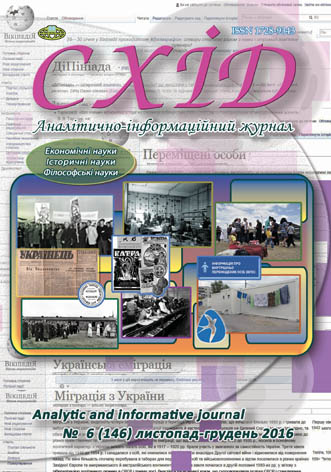The public and private sectors of the economy: historical aspects of cooperation
DOI:
https://doi.org/10.21847/1728-9343.2016.6(146).91796Keywords:
public-private partnership (PPP), history, protoform, occurrence, developmentAbstract
The article reviews the development of interaction between private capital and the state as a public-private partnership (PPP). The basic model of the original PPP, given their basic characteristics, considered the economic conditions of their origin and functioning.
Historically, the first form of public-private partnership made it possible to state to realize their economic, political and other interests. These relations continued to exist as long as the level of development of the state and its institutions are not given the opportunity to maximize the latter belonging to perform her functions. Protoforms PPP were not acts of the partnership (with the exception of certain elements of concession relations), and the delegation of certain functions of the state or the private sector elements. Therefore, most of the models of interaction between government and business have ceased to exist, and because so far the state is now true mainly for financial reasons, are not able to fully satisfy the public interest, to replace protoforms in the second half of the twentieth century. emerged and began to develop modern forms of public-private partnership.
Downloads
References
Deryabina, M. (2008), Public-private partnerships: theory and practice, Voprosy Economiki (Moscow), № 8; 61-77 (rus).
Linev, I.(2011, January - March), From foreign experience the conclusion and implementation of concession agreements, Miestnoye samoupravleniye v Rossiyskoy Federatsii [Local Self-Government in the Russian Federation], p.45 (rus).
Talapina, E. (2009), Concession as a form of public-private partnership, Khoziaystvoipravo [Economy and the Law], № 4, p.72 (rus).
Agamben, G. Foreign concessions: the past and future of a form of shared sovereignty, available at: http://risingpowers.open.ac.uk/documents/Publication/Extraterritoriality_print.pdf
Hodge, G. and Greve, C. (2005), The challenge of public-private partnerships: learning from international experience, Edward Elgar Publishing, Oxford, 368 p. DOI: 10.4337/9781845428082.
Wettenhall, R. Thinking seriously about public-private partnerships as an MDG tool, available at: //http://unpan1.un.org/intradoc/groups/public/documents/eropa/unpan026304.pdf
Kapoguzov, E.A. and Solovyov, Y.V. (2011), Public-private partnership - the origins and evolution, Coll. works of Donetsk National Technical University. Ser. Economic, Vol. 40-1, pp. 106-111 (rus).
Kurys, N.V. (2011), Public-private partnership as a historical and legal phenomenon, Society and Law, № 2, pp. 30-35 (rus).
Hellowell, Mark. (2010), The UK’s Private Finance Initiative: history, evaluation, prospects. In: Hodge, Graeme, Greve, Carsten & Boardman, Anthony. Eds. International Handbook on Public-Private Partnerships. Cheltenham, Edward Elgar and others. DOI: 10.4337/9781849804691.00023.
Caiden, N. (1980), Budgeting in Poor Countries: Ten Common Assumptions Re-Examined. Public Administration Review, Vol. 40, No. 1, pp. 40-46. DOI: 10.2307/976107
Telliford, George T. [editor] (2009), Public-private partnerships around the world, Nova Science Publishers, NY, 345 p. (eng).
Andrews, Kenneth R. (1964), Elizabethan Privateering: English Privateering During the Spanish War, 1585-1603, Cambridge University Press, Cambridge, 356 p.
Klein, R. (2005), The public-private mix in theUK, in: Maynard, A. (ed.) The Public Private Mix for Health,London: Nuffield Trust, 43-62 (eng).
Dupuy, T. (1970), The Encyclopedia of Military History, Janes Publishing Company, NY: Harper and Row, р.117 (eng).
Braylovskyy, I. A. (2014), Models and mechanisms of state-private partnership: implementation in Ukraine, East Publishing House, Donetsk, 375 p. (ukr).
Downloads
Published
How to Cite
Issue
Section
License
Copyright (c) 2017 Illia Brailovskyi

This work is licensed under a Creative Commons Attribution-NonCommercial-NoDerivatives 4.0 International License.
1. Authors bear responsibility for the accuracy of facts, quotations, numbers and names used.
2. Manuscripts are not sent back.
3. The publisher does not always agree with the authors' opinion.
4. The authors reserve the right to authorship of the work and pass the first publication right of this work to the journal under the terms of a Attribution-NonCommercial-NoDerivatives 4.0 International, which allows others to freely distribute the published research with the obligatory reference to the authors of the original work and the first publication of the work in this journal.
5. The authors have the right to conclude separate supplement agreements that relate to non-exclusive work distribution in the form in which it has been published by the journal (for example, to upload the work to the online storage of the journal or publish it as part of a monograph), provided that the reference to the first publication of the work in this journal is included.

